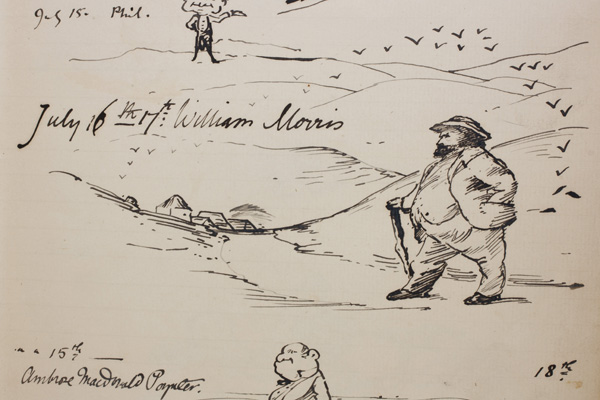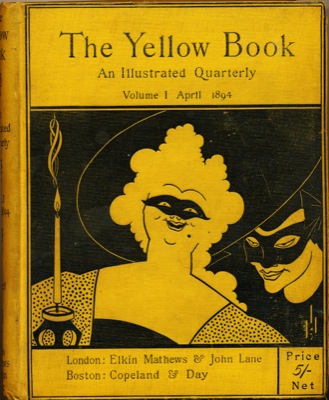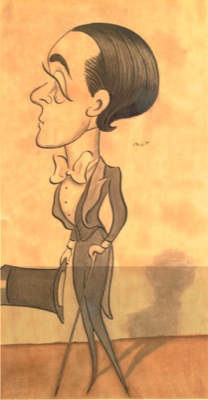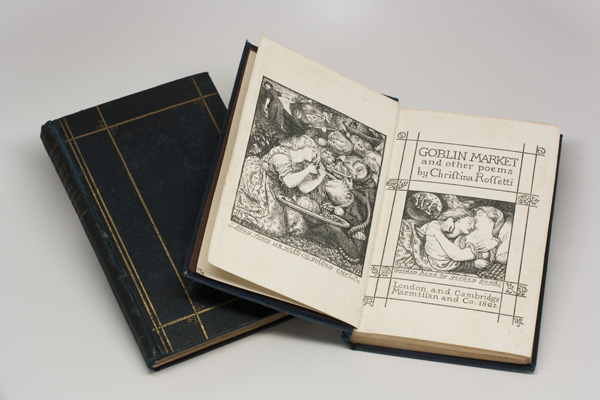


Printed treasures
Works from Samuels Lasner Collection featured in National Gallery of Art exhibition
http://www.udel.edu/udaily/2013/mar/samuels-lasner-collection-030713.html8:22 a.m., March 7, 2013--Victorian printed treasures and artifacts from the Mark Samuels Lasner Collection seem to be gracing exhibitions everywhere this spring.
Associated with the University of Delaware Library and housed in the Morris Library, the collection focuses on British literature and art of the period 1850 to 1900, with an emphasis on the Pre-Raphaelites and on the writers and illustrators of the 1890s.
The exhibition featuring the most works from the collection is “Pre-Raphaelites and the Book, which accompanies “Pre-Raphaelites: Victorian Art and Design, 1848-1900,” the first major survey of the art of the Pre-Raphaelites to be shown in the U.S. Both exhibits are at the National Gallery of Art in Washington, D.C., through May 19.
“The big National Gallery of Art exhibition is the American counterpart to the ‘Pre-Raphaelites: Victorian Avant-Garde’ that was at the Tate Britain in London,” said Mark Samuels Lasner, senior research fellow at the UD Library. “There are loans from the Delaware Art Museum — such as the iconic Lady Lilith, by Dante Gabriel Rossetti — so I am delighted that that the curators also asked for works from my collection. It’s not a joke to say that Delaware has more Pre-Raphaelite art per capita than any place else in the United States.”
Objects from the Samuels Lasner Collection in “Pre-Raphaelites: Victorian Art and Design, 1848-1900,” comprise an early Edward Burne-Jones self-caricature (showing the artist seated on one of the chairs, decorated by Rossetti and William Morris, in the Delaware Art Museum’s collection, and also on view); Kelmscott Press books; and the Morris printed textile, Strawberry Thief.
Of the 26 books, prints, drawings, and manuscripts in “Pre-Raphaelites and the Book,” 22 are from the Samuels Lasner Collection. “My two favorites are the illuminated calligraphic manuscript of the catalogue of William Morris’s library and the Visitor’s Book for North End House, Rottingdean, by Edward Burne-Jones,” Samuels Lasner said. “They are the two ‘stars’ of the show.”
The Burne-Jones manuscript shows the names of visitors annotated with humorous drawings, and includes a rendering of a rotund William Morris heading out for a countryside stroll.
The Mark Samuels Lasner Collection is also represented in exhibitions in New York City, Rhode Island and the University’s Old College Gallery.
“American Little Magazines of the 1890s: A Revolution in Print,” runs from April 26 to Aug. 18 at the Grolier Club in New York City. The show looks at the decade that saw the birth of the little magazine, and documents their association with modern art movements and alternative social and cultural trends.
Samuels Lasner noted that loans from his collection, such as The Yellow Book and an Aubrey Beardsley poster, show the origin of the movement in Britain.
“This phenomenon came at the time of the poster craze, and coincided with the burgeoning world of advertising,” Samuels Lasner said. “Many of these little magazines might be called the zines and blogs of their day, the personal creations of individuals or small groups of friends and associates.”
Samuels Lasner will moderate a Collectors’ Forum at the Grolier Club on March 13 featuring Susan Barribeau, a curator at University of Wisconsin-Madison Libraries and co-lenders Phillip R. Bishop, David M. Lowden and Jean-Francois Vilain, as they discuss their collections and the place of the little magazines of the 1890s within them.
“Artist/Rebel/Dandy,” on view April 28 to Aug. 18 at the Museum of Art, Rhode Island School of Design, in Providence, R.I., celebrates that indispensable man of sophistication and refinement, the dandy.
Beginning with George Bryan (Beau) Brummell, in the early 19th century, famous dandies have ranged from George IV and Oscar Wilde to contemporary counterparts Thom Brown, Rick Owens, Ouigi Theodore and Waris Ahluwalia.
“I have contributed nine items, including several relating to Max Beerbohm, the most significantly represented figure in my collection. The items include original Beerbohm caricatures, his walking stick and even some clothes from my personal wardrobe,” Samuels Lasner said. “The RISD Museum specializes in fashion and I know this is going to be a fabulous exhibition. I am glad that they asked me to contribute, though I shall miss wearing one of my favorite suits.”
“Gertrude Käsebier: The Complexity of Light and Shade,” which runs through June 28 in the university’s own Old College Gallery, includes The Round Rabbit by Agnes Lee.
Published by Boston, Copeland and Day in 1898, and part of the Mark Samuels Lasner Collection, the book features illustrations by Rose O’Neil, the inventor of the Kewpie Doll.
“Agnes Lee was a poet and a model for Gertrude Käsebier,” Samuels Lasner said. “Lee was introduced to Käsebier by F. Holland Day, publisher of The Round Rabbit. Rose O’Neil was also photographed by Kasebier; there are therefore many connections represented by this one single book.”
Growing up with his grandparents in an 1890s house in Black Rock, Conn., Samuels Lasner’s affinity with all things Victorian is both personal and professional.
“We had a family friend, May Bradshaw Hays, who was born in London in 1880 and had known William Morris and Edward Burne-Jones,” Samuels Lasner recalled. “When I graduated from college, she gave me a pair of decorative tiles painted by Burne-Jones’s assistant and the five remaining pieces from a blue-and-white tea set given to her parents by Morris and his wife, Jane, So the Pre-Raphaelites have a strong personal, as well as an intellectual attraction.”
Article by Jerry Rhodes


